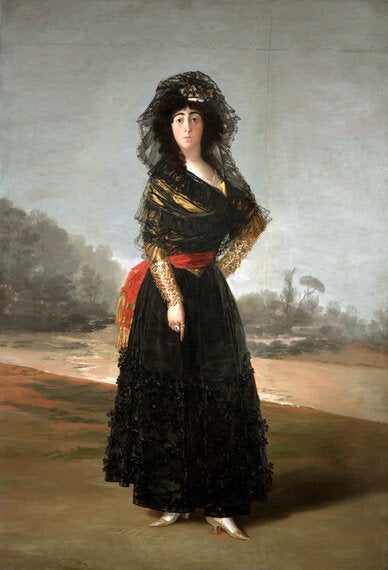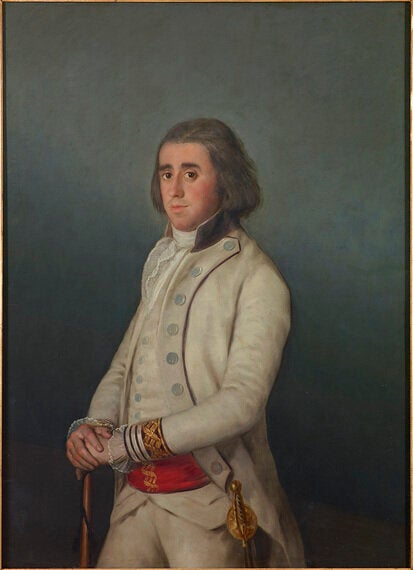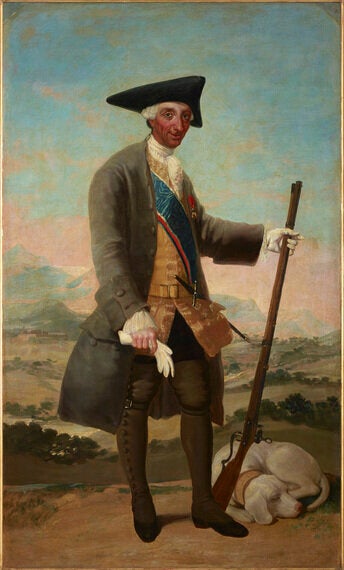
Incredibly, the new Goya exhibition at the National Gallery is the first ever to focus solely on this great man's work as a portraitist. About 150 of Goya's portraits survive today and half of these have been curated together into this unprecedented exhibition that includes work from across his career - from his early days in the court of Madrid, to dramatic works completed in his last years in self-imposed exile in France.
There is such talent, such genius in Goya's work that it's hard to know where to begin. His technical excellence is just ridiculous - the skin tone, glimpses of veins in ageing hands, the delicacy of the mantilla lace, the shimmering texture of the satin dresses, the flash of colour from sashes and hat linings, the bold, bare backgrounds...
But more than this, beyond his technical brilliance, Goya captured the inner spirit of his sitters. He brought out their personalities, their character. This ability to humanise the even the most regal of sitters, to bring informality to such formal arrangements, is the hallmark of Goya.

The 70 portraits on show demonstrate Goya's genius beautifully and include works that have never been exhibited publicly before, having remained in the possession of descendants of the sitters, and some that are rarely lent. This includes the impressive Duchess of Alba, 1797, which has only once left the United States, and has never before travelled to Britain, and the delicate and intriguing portrait of Don Valentin Bellvis de Moncada de Pizarro, 1795, which is on public display here for the first time ever.
The exhibition is hung in chronological order and, interestingly, with no explanatory text printed on the wall in each room to give an overview of the paintings. Not that much explanation is needed. But it allows us to observe how Goya's skills and style developed over time.
In the earlier works, such as Maria Teresa de Vallabriga y Rozas on Horseback, 1783, and Don Luis Maria de Borbon y de Vallabriga, 1783, there is still an air of formality about the pose, sitters are beady-eyed, and their mood and personality not always easy to read.
Yet as the exhibition progresses, you can see the development of Goya's talent and the evolution of his signature style.

The Dowager Marchioness of Villafranca, 1796, on loan from the Prado, is a beautiful painting that depicts this elderly woman in her finest dress, yet blends that with the quiet contemplation of her pose and the warmth in her eyes that glance up towards us. There is such tenderness in this portrait, which has been painted with such compassion and humanity.
At the other end of the spectrum is the glorious portrait of the French ambassador Ferdinand Guillemardet, 1798. This handsome man is in all the required finery, his sword tied to his waist by a scarf in the bright colours of the new French republic, yet he is reclining in a chair with all the ease of a man who is amongst friends.
And then there is the astonishing portrait of Charles III, Charles III in Hunting Dress, 1786-1788. Gone is the usual depiction of royalty with stiff straight backs and flawless handsome features. Instead this king, well, it's not flattering to put it kindly. This is very much a king who wants to be seen as a 'man of the people' and Goya has captured an approachable demeanour to his face - a kindly father figure rather than a king to be feared.

Goya's reputation was made in his work on the Spanish aristocracy and though these are impressive and brilliant, it is the room dedicated to portraits he made of his close friends that, for me, dazzles most of all. The depth of his affection for them is evident and the results are a series of sensitive portraits that just brim with intimacy and warmth, whether it's the elusive mood of the actress Antonia Zarate, about 1805, or the fullness under the chin in the portrait of his best friend, Martin Zapater, 1797.
Goya's dazzling brilliance is beyond doubt and this exhibition offers a unique, maybe once in a lifetime opportunity, to witness some of this master's finest work up close. Take this opportunity.
National Gallery, London to January 10, 2016
Image Credits:
1.Francisco de Goya, The Duchess of Alba, 1797, Oil on canvas 210.1 × 149.2 cm. On loan from The Hispanic Society of America, New York, NY © Courtesy of The Hispanic Society of America, New York
2.Francisco de Goya, Don Valentín Bellvís de Moncada y Pizarro, around 1795 Oil on canvas 115 x 83 cm. Fondo Cultural Villar Mir, Madrid © Fondo Cultural Villar Mir, Madrid
3.Charles III in Hunting Dress, Francisco de Goya, 1786-84. Oil on canvas 210 x 127 cm © Photo courtesy of the owner.
4.Francisco de Goya, Martín Zapater, 1797 Oil on canvas 83 x 65 cm Bilbao Fine Arts Museum © Bilboko Arte Ederren Museoa-Museo de Bellas Artes de Bilbao